
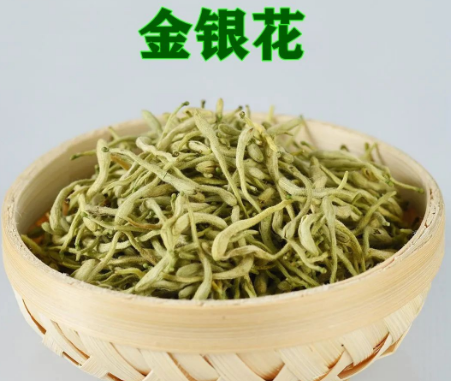
Name: 金银花 (Jīn Yín Huā)
Pinyin: Jīn Yín Huā
Alias: 银花 (Yín Huā), 双花 (Shuāng Huā), 二花 (Èr Huā), 二宝花 (Èr Bǎo Huā)
Source: This herb is derived from the dried flower buds or early blooming flowers of the Lonicera japonica (Japanese honeysuckle) or Lonicera macranthoides (large-flowered honeysuckle). It is harvested in early summer before the flowers bloom and then dried.
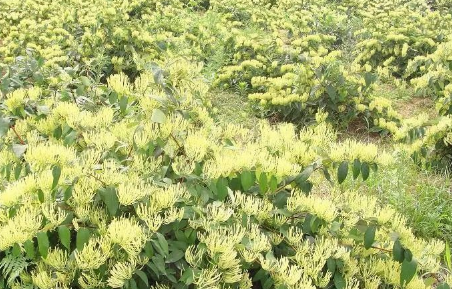
Characteristics: The honeysuckle is rod-shaped, thicker at the top and tapering towards the bottom, slightly curved, measuring 2-3 cm in length, with a diameter of about 3 mm at the top and about 1.5 mm at the bottom. The surface is yellowish-white or greenish-white (darkening with prolonged storage) and densely covered with short soft hairs. Occasionally, leaf-like bracts can be seen. The calyx is green, with five lobes at the tip, and the lobes are hairy, about 2 mm long. The corolla is tubular and bilabiate at the tip; there are five stamens attached to the wall of the tube, yellow in color; and one pistil with a hairless ovary.
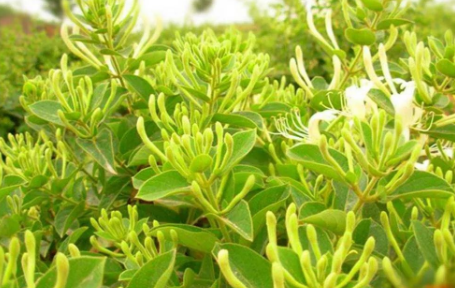
The scent is fragrant, with a mild and slightly bitter taste. The red-stemmed honeysuckle measures 2.5-4.5 cm in length and 0.8-2 mm in diameter. The surface is yellowish-white to yellow-brown, hairless or sparsely hairy. The calyx tube is hairless, with five lobes at the tip, and the lobes are triangular and hairy. The corolla’s lower lip is often inverted. The flower column is hairless. The mountain honeysuckle measures 1.6-3.5 cm in length and 0.5-2 mm in diameter. The calyx tube and corolla are densely covered with grayish-white hairs, and the ovary is hairy. The hairy-flowered honeysuckle measures 2.5-4 cm in length and 1-2.5 mm in diameter. The surface is light yellow with a slight purple hue, hairless. The lobes of the calyx are short and triangular. The corolla’s upper lip is often irregular, and the lower part of the flower column is densely covered with long soft hairs.
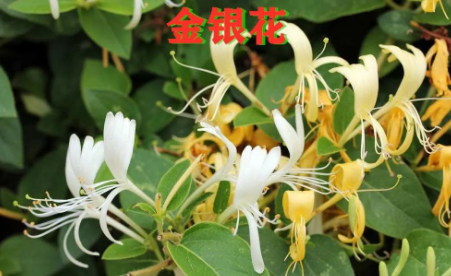
Preparation: 1. Honeysuckle: Remove sand and impurities.
2. Charred honeysuckle: Take the cleaned honeysuckle, place it in a pot, and stir-fry over high heat until it turns dark brown, then spray with clean water, remove, and dry.
Taste and Properties: Sweet, cold.
Meridians Entered: Lung (肺), Heart (心), Stomach (胃).
Functions: Clears heat and detoxifies, disperses wind-heat. Used for abscesses, sore throat, erysipelas, heat-toxicity dysentery, wind-heat colds, and febrile diseases.
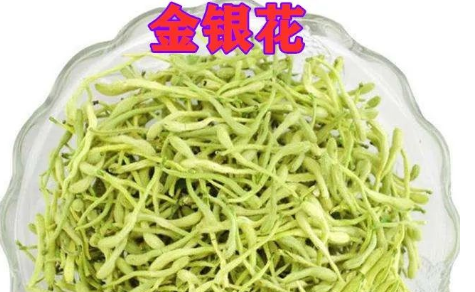
Functions:
1: Antimicrobial action. It has a certain inhibitory effect on various pathogenic bacteria such as Staphylococcus aureus, hemolytic streptococcus, Escherichia coli, dysentery bacillus, cholera vibrio, typhoid bacillus, and paratyphoid bacillus.
2: It has bacteriostatic and bactericidal effects against pneumococcus, meningococcus, Pseudomonas aeruginosa, Mycobacterium tuberculosis, Shigella dysenteriae, and Proteus vulgaris, and has inhibitory effects on influenza virus, orphan virus, herpes virus, and Leptospira.
3: Anti-inflammatory and detoxifying effects, with strong ability to disperse abscesses and reduce swelling, and to clear heat and detoxify for abscesses, intestinal abscesses, and lung abscesses.
4: Disperses heat and expels evil, effective for external wind-heat or the initial stage of warm diseases, with symptoms such as fever, headache, irritability, insomnia, confusion, red tongue, dry throat, and dry mouth.
5: Honeysuckle tea is sweet and cold in nature, with functions of clearing heat and detoxifying, and dispersing wind-heat. Honeysuckle can clear heat and detoxify, soothe the throat, and relieve summer heat and irritability. It can treat summer heat syndrome, dysentery, influenza, abscesses, acute and chronic tonsillitis, and periodontal disease.
Honeysuckle has a cold nature and is not suitable for long-term consumption; it is only suitable for temporary use in hot summer to prevent and treat dysentery. It is particularly important to note that those with a deficiency-cold constitution and during menstruation should not consume it, as it may cause adverse reactions. It is better to drink it when feeling heat, as excessive consumption may have the opposite effect.
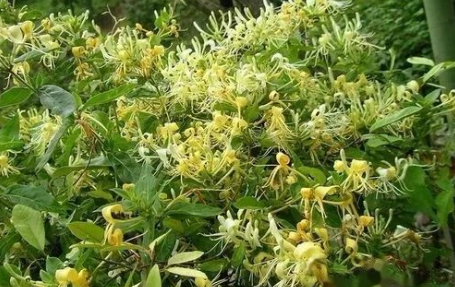
Effects:
1. Antimicrobial action. It has a certain inhibitory effect on various pathogenic bacteria such as Staphylococcus aureus, hemolytic streptococcus, Escherichia coli, dysentery bacillus, cholera vibrio, typhoid bacillus, and paratyphoid bacillus.
2. It has bacteriostatic and bactericidal effects against pneumococcus, meningococcus, Pseudomonas aeruginosa, Mycobacterium tuberculosis, Shigella dysenteriae, and Proteus vulgaris, and has inhibitory effects on influenza virus, orphan virus, herpes virus, and Leptospira.
3. Anti-inflammatory and detoxifying effects, with strong ability to disperse abscesses and reduce swelling, and to clear heat and detoxify for abscesses, intestinal abscesses, and lung abscesses.
4. Disperses heat and expels evil, effective for external wind-heat or the initial stage of warm diseases, with symptoms such as fever, headache, irritability, insomnia, confusion, red tongue, dry throat, and dry mouth.
5. Cools blood and stops dysentery, effective for heat-toxicity dysentery, purulent blood dysentery, damp-heat obstructing the throat, and throat swelling and pain.
6. Honeysuckle tea is sweet and cold in nature, with functions of clearing heat and detoxifying, and dispersing wind-heat. Honeysuckle can clear heat and detoxify, soothe the throat, and relieve summer heat and irritability. It can treat summer heat syndrome, dysentery, influenza, abscesses, acute and chronic tonsillitis, and periodontal disease.
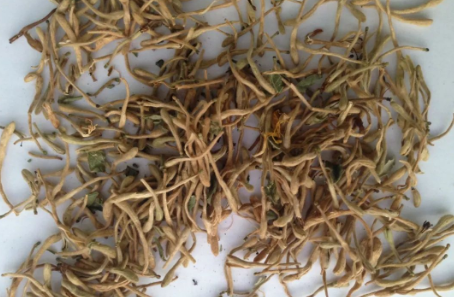
Various Discussions:
1. From “Bencao Tongxuan”: Honeysuckle is primarily used for abdominal distension and diarrhea, dispersing abscesses and detoxifying, replenishing deficiency and treating wind. People only know its detoxifying function, but are unaware of its use for abdominal distension and wind deficiency. It has been effective for various symptoms when used.
2. From “Bencao Zheng”: Honeysuckle is good at transforming toxins, thus treating abscesses, swellings, sores, and various toxins. It is indeed an essential medicine. It can disperse undeveloped toxins and can also help mature existing ones, but its nature is mild, so it should be used in larger quantities, either cooked with wine or juiced and mixed with wine for immediate consumption, or ground and mixed with wine for topical application. For treating toxins in the upper qi level, using one or two liang regularly in decoction is very effective.
3. From “Bencao Fengyuan”: Honeysuckle detoxifies and removes pus, with a combination of purging and tonifying effects, being a holy medicine for abscesses after they have ruptured. However, those with qi deficiency and clear pus, with little appetite and diarrhea should not use it. For smallpox that has sunk and not risen, use the root boiled in water for bathing, which is effective for enhancing the appearance of the smallpox.
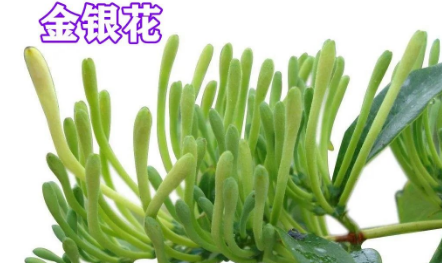
4. From “Diannan Bencao”: Clears heat and resolves various sores, abscesses, and erysipelas.
5. From “Shengcao Yaoxing Beiyao”: Can disperse abscesses, stop dysentery, wash sores, and eliminate blood heat from the skin.
6. From “Bencao Beiyao”: Nourishes blood and quenches thirst. Treats scabies and eczema.
7. From “Chongqing Tang Suibi”: Clears wind-heat and damp-heat, resolves warm epidemic toxins, calms the liver and gallbladder, and treats convulsions and epilepsy.
8. From the Guangzhou Military Region “Commonly Used Chinese Herbal Medicine Manual”: Clears heat and detoxifies. Treats external febrile cough, enteritis, bacterial dysentery, measles, mumps, septicemia, abscesses, and infections, as well as heat rash in children. Made into a cooling tea, it can prevent heatstroke, colds, and intestinal infectious diseases.
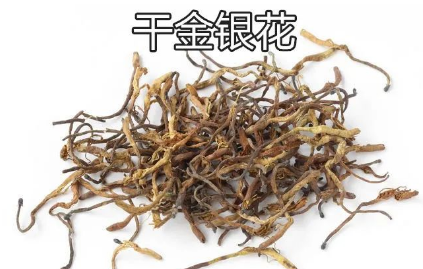
Side Effects:
Fresh honeysuckle flowers have a pleasant fragrance and contain a lot of nectar, which rural children often suck for the sweet juice. Fresh flowers are dried or processed like green tea to produce honeysuckle. There are two types of honeysuckle tea on the market: one is made by mixing fresh honeysuckle with a small amount of green tea, processed according to flower tea techniques; the other is made by mixing dried honeysuckle with green tea. The former has a strong floral fragrance, primarily for enjoying the aroma; the latter has a lower floral fragrance but retains the medicinal effects of honeysuckle, maintaining its health benefits.
Honeysuckle has a cold nature and is not suitable for long-term consumption; it is only suitable for temporary use in hot summer to prevent and treat dysentery. It is particularly important to note that those with a deficiency-cold constitution and during menstruation should not consume it, as it may cause adverse reactions. It is better to drink it when feeling heat, as excessive consumption may have the opposite effect.
The above content is extracted from the internet, with gratitude to the original author!

